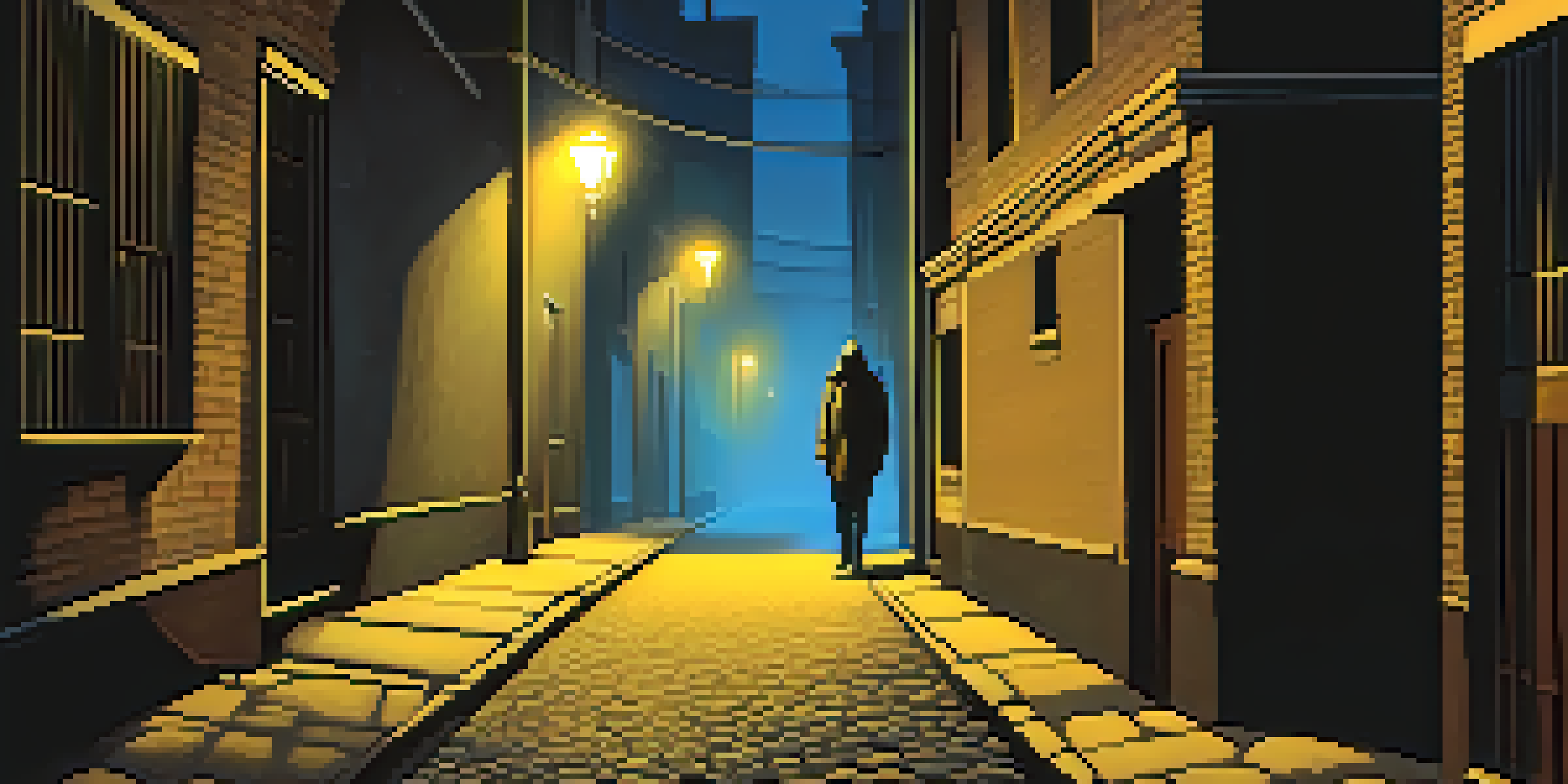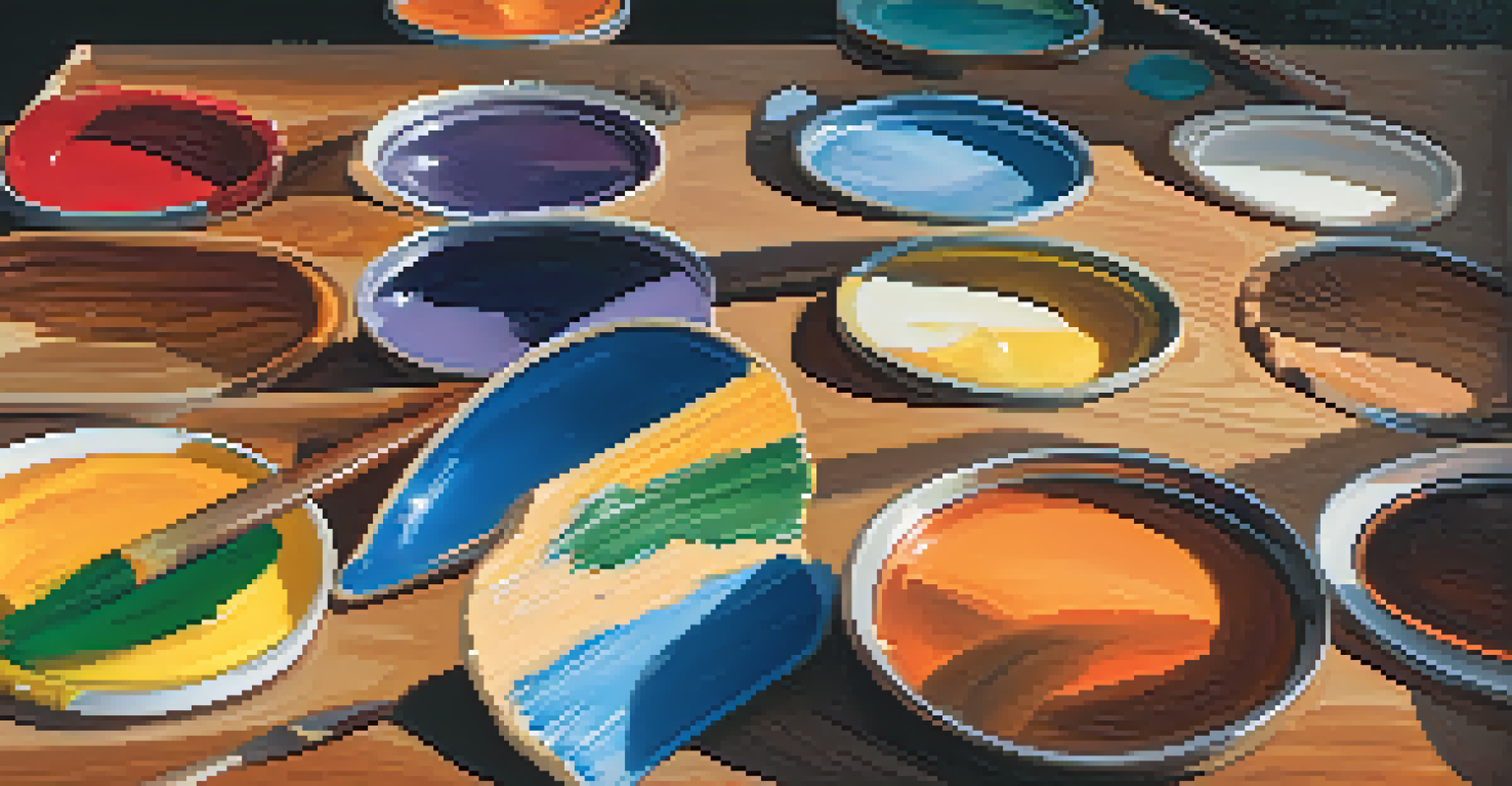Shadows and Highlights: Their Narrative Significance in Film

Understanding Shadows and Highlights in Film
In film, shadows and highlights serve as visual storytelling tools that enhance the narrative. Shadows often represent mystery, danger, or the unknown, while highlights can signify hope, clarity, or truth. By manipulating light and dark, filmmakers can guide audience emotions and perceptions of the story.
Light and shadow are the two elements that make up the language of film.
Consider the classic film noir genre, where heavy shadows create a sense of suspense and intrigue. The interplay of light and dark not only shapes the visual aesthetic but also reflects the characters' inner struggles. This foundational understanding of shadows and highlights sets the stage for deeper analysis of their narrative significance.
Ultimately, these elements are not merely technical choices; they are integral to the storytelling process. Their roles expand beyond visuals, influencing how audiences connect with characters and themes throughout the film.
Historical Context: Shadows and Highlights in Cinema
Historically, the use of shadows and highlights in film can be traced back to early silent films, where lighting techniques were crucial for conveying emotion. Pioneers like F.W. Murnau utilized light and shadow to evoke strong feelings, paving the way for future filmmakers. This early experimentation laid the groundwork for understanding visual storytelling.

As cinema evolved, directors began to manipulate these elements to enhance narrative depth. For instance, the chiaroscuro technique, which uses strong contrasts between light and dark, became a staple in films like 'The Cabinet of Dr. Caligari.' This artistic approach not only created visually stunning scenes but also added layers to the story.
Visual Tools for Storytelling
Shadows and highlights are crucial visual storytelling tools that influence audience emotions and perceptions in film.
Today, filmmakers continue to draw inspiration from these historical techniques, adapting them to modern storytelling. The legacy of shadows and highlights remains a testament to their power in shaping cinematic narratives.
Emotional Resonance: Shadows and Highlights in Character Development
The emotional resonance of shadows and highlights is profound, particularly when it comes to character development. Shadows can evoke feelings of fear or uncertainty, reflecting a character's internal conflict or moral ambiguity. Conversely, highlights can illuminate moments of revelation, growth, or redemption.
In every film, shadows can represent more than mere absence of light; they can embody themes of fear, mystery, and the unknown.
Take, for example, the way a character is lit during a crucial moment in their arc. A dimly lit scene can signify their struggle, while a sudden burst of light may symbolize a turning point or newfound clarity. This visual language allows audiences to connect with the characters on a deeper level, fostering empathy and understanding.
By carefully crafting these visual cues, filmmakers can guide the audience's emotional journey. The interplay of shadows and highlights becomes a powerful tool in revealing the complexities of human experience.
Symbolism in Film: Shadows and Highlights as Narrative Devices
Shadows and highlights are rich with symbolism, often representing broader themes within a film. Shadows might symbolize oppression, danger, or the past, while highlights can represent hope, truth, or a brighter future. This symbolic nature adds depth to the narrative, inviting viewers to interpret the story on multiple levels.
For instance, in films dealing with themes of duality or conflict, shadows often represent the darker aspects of characters or situations. Conversely, highlights can signify moments of clarity or resolution, effectively framing the narrative arc. Such symbolism engages the audience, encouraging them to look beyond the surface.
Historical Techniques in Cinema
The use of shadows and highlights has evolved from early silent films to modern cinema, shaping narrative depth and emotional resonance.
As viewers, recognizing these symbols enhances our understanding of the film's message. The interplay of shadows and highlights becomes a dialogue between the filmmaker and the audience, enriching the overall cinematic experience.
Cinematic Techniques: How Filmmakers Use Shadows and Highlights
Filmmakers employ a variety of techniques to manipulate shadows and highlights, each contributing to the narrative's impact. Techniques such as low-key lighting create stark contrasts, enhancing suspense and drama. In contrast, high-key lighting can create a more cheerful or energetic atmosphere, influencing the audience's mood.
Consider how a director might use backlighting to create silhouettes, adding an air of mystery to a character's entrance. This technique not only visually captivates the audience but also hints at the character's intentions or backstory, further enriching the narrative. The choices filmmakers make with lighting are deliberate and carefully crafted.
Understanding these techniques allows audiences to appreciate the artistry behind the scenes. Each choice regarding shadows and highlights shapes the film's overall tone, reinforcing the narrative in powerful ways.
Case Studies: Iconic Films and Their Use of Shadows and Highlights
To truly grasp the significance of shadows and highlights, we can examine iconic films that masterfully utilize these elements. For instance, 'Blade Runner' employs dramatic lighting to create a dystopian atmosphere, where shadows evoke feelings of isolation and despair. These visual choices resonate with the film's themes of identity and humanity.
Another example is 'The Godfather,' where lighting plays a crucial role in character portrayal. The use of shadows during pivotal scenes emphasizes the moral ambiguity of the characters, drawing the audience deeper into their complex relationships. Such case studies illustrate the profound impact of shadows and highlights on narrative.
Symbolism Enhancing Narratives
Shadows and highlights serve as symbols within films, representing themes like danger, hope, and moral complexity, enriching the audience's viewing experience.
By analyzing these films, we see how shadows and highlights are not just technical aspects but essential components of storytelling. They enhance the narrative, making the viewing experience all the more compelling.
Conclusion: The Lasting Impact of Shadows and Highlights in Film
In conclusion, shadows and highlights are vital tools in the filmmaker's arsenal, shaping narratives in profound ways. Their emotional resonance, symbolic significance, and technical applications contribute to the depth and richness of storytelling in cinema. As we continue to explore films, recognizing these elements enhances our appreciation for the art of filmmaking.
Just as a painter uses light and shadow to create depth on canvas, filmmakers use these elements to craft unforgettable stories. The interplay of shadows and highlights invites us to engage with the narrative on multiple levels, enriching our viewing experience.

As audiences, we can cultivate a deeper understanding of cinema by paying attention to these visual cues. Shadows and highlights are more than mere aesthetics; they are powerful narrative devices that resonate long after the credits roll.